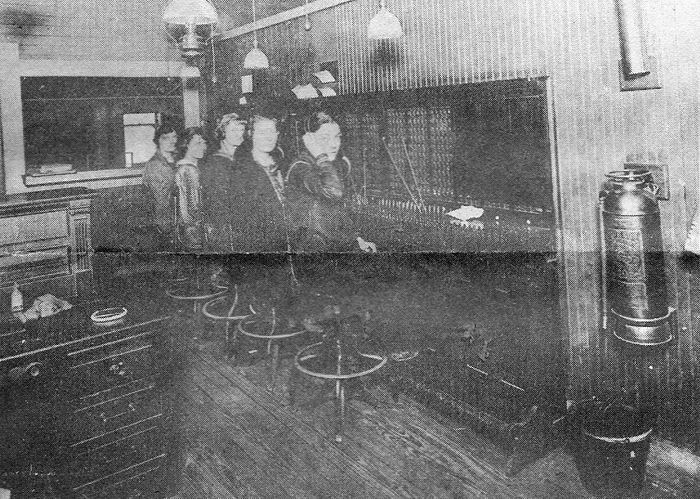 |
| 1916 Telephone Exchange - Operators not Identified |
Number Please
 |
| 1916 Telephone Exchange - Operators not Identified |
The first telephone exchange in
Center was built by R. W. Mills and R. T. Crawford as owners in 1897 and housed
in a building owned by R. L. Parker. The building is still standing
and is on the corner of Nacogdoches and Tenaha Streets, next to the Rio Theater.
The exchange began operation with 18 subscribers; R. W. Mills, T. R. Crawford,
B. F. Bridges, W. T. Wilson, W. J. Lister, J. L. Crawford, Dr. E. E. Leek, Judge
Tom Davis, Judge James Polley, H. .N.Runnels, Dr. J. W. Rogers, J. E. Armstrong,
Jesse Padon, T. S. McKnight, J. D. Redditt, S. T. Fleshman, W. B. Downer and R.
L. Parker.
R. W. Mills tried to sign up John
Sanders, as an original subscriber, but Mr. Sanders refused because "anybody
ought to know that you can't talk over a wire." After the exchange was in
successful operation, Mr. Sanders tried to get a phone immediately, but there
was not enough wire on hand to run him a circuit. Finally Mr. Mills let
him tie into his line then use one and Half miles of barbed wire fence for the
balance of the Distance. The phone was installed and put in service until
additional wire was secured.
The first long distance phone
call from Center was made by R. W. Mills to Miss Nannie Powell of Terrell.
This was the beginning of a romance that led to their later marriage.
When the Southwestern
Bell Telephone Company cut over to dial system, Mr. Bob and Miss Nannie were the
guests of honor and place a phone call to Miss Ellie Mills, later was Mrs.
Earnest Wilson of Dallas, who was the first Center operator and worked the first
call made from Center.
Miss Etta Day was one of the early operators on the
Center Exchange, serving from 1900 to 1906. Mrs. Evie Day was employed as
an operator in 1903 and was made first Chief operator in 1910.
In
1901, J. E. Armstrong and Mr. Fisher, purchased the exchange from Mr. Wills and
Mr. Crawford, but nonpayment of local and long distance bills, they were forced
to sell out in a few months. During their ownership the operators were
paid $5.00 per week. Mr. O. H. Polley bought the exchanged and in 1901 sold to
W. A. King in 1902. Mr. C. B. Hagan was Manager of the exchange for years.
The phone rate was $1.25 per month. Southwestern Bell Telephone Company
purchased the company in 1915.
Among
the first operators under the Bell System were Lillie Mae Lout, Fay Christian,
Jennie Sanders, Rosa Irish (2nd Chief Operation), Polly Ford, Mildred Samford and
Ollie Samford Dinkley.
When
Southwestern purchased the exchange it was what was called the ringer type
phone. All phones were rather large boxes and were usually nailed on the
wall, high enough that children could not reach. To get an operator youj
grasped the handle of the generator and gave it a few vigorous turns before the
receiver was removed. This generated a current and caused a tiny door to
fall open at the exchange and make a buzzing sound. The operator plugged
in and asked for your number. If a child had gotten to the phone and told
the operator "I want my moma." The operator knew who the mother was and
where she might be. Adults usually told the operator that they
wanted to talk to "Tom" or "Mary", the meat market or grocery store. The
operator knew where everyone traded, so it was no problem to get the right one.
After
Southwestern made improvements in the exchange and expanded the radius of
exchange, people were urged to begin using the directory and call by number.
Later Southwestern Bell changed over to "Common Battery" system which required
to lift the receiver and the operator would see a light and answer. The
serious disadvantage to this system was that when the operator did not answer,
it was impossible to vent you anger.
|
|
|
Bob Wills and Nannie? at Telephone Open House
Held when |
Some time
during the King ownership of the exchange, there was a change in the numbering
system. Hayes Bros. Laundry was No. 1; Framers Bank 93; J. C. Rogers Drug
Store 95; Santa Fe Depot 146; P. H. Smith Grocer 57; J. A. Sanders home 128.
These same numbers were used until the company went to dial and many of he old
numbers are still found as the last digits of the seven number system.
In 1956,
Southwestern put Center on Dial, the present telephone building was constructed
and all equipment installed and a instant cut over. Barnette Sanders had
at one time two of the original telephones used in Mills and Crawford's
exchange, but these were destroyed by fire.
Shelby County museum has some of the original telephone books for your viewing. (Donated by Mrs. David Chadwick)
From East Texas Light/Kay Sanders